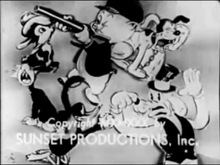Sunset Productions, Inc. was a television production and licensing subsidiary of Warner Bros. Pictures[1][2] headed by Jack M. Warner.[3] It was an entity separate from Warner Bros. Television.[4]

History
editSunset was originally established as a subsidiary of Warner Bros. that focused on television.[3] Its first production was a series of half-hour shows.[3]
On February 12, 1955, Warner Bros. sold the TV distribution rights to 191 of their black-and-white cartoons to Guild Films[5] through Sunset.[6] The cartoons part of the deal were all black-and-white Looney Tunes shorts and all black-and-white non-Harman-Ising Merrie Melodies shorts. All references to Warner Bros. in the cartoons were removed because Warner did not want to antagonize theater owners as a result of their television deals.[1] Guild Films would hold onto the TV distribution rights to the cartoons until its bankruptcy on March 6, 1961,[7] after which the TV rights to the 191 cartoons would be acquired by Seven Arts Productions.[8]
Sunset eventually began to produce TV commercials. In April 1957, Sunset Productions changed its name to Warner Bros. TV Commercial and Industrial Films. Jack M. Warner would continue to run the subsidiary.[9][10]
References
edit- ^ a b "Guild Acquires 191 WB Cartoons". Variety. February 16, 1955.
- ^ Anderson, Christopher (1994). Hollywood TV: The Studio System in the Fifties. University of Texas Press. ISBN 9780292730595.
- ^ a b c "Trio of Majors Accelerate Television Plans". The Independent Film Journal. April 16, 1955.
- ^ "Ross Reports - Mid-Week Special". Television Index. May 4, 1955.
- ^ "Warner Bros. Sells First Films". Billboard. Nielsen Business Media Inc. February 19, 1955.
- ^ "Film Distribution". Broadcasting Telecasting. March 7, 1955.
- ^ "SEC Charges Guild Films Failed to Show True Facts". Broadcasting Telecasting. March 6, 1961.
- ^ "Film on Tap at NAB Convention". Sponsor Publications. May 8, 1961.
- ^ "Jack M. Warner". Broadcasting Telecasting. November 4, 1957.
- ^ Anderson, Christopher (1994). Hollywood TV: The Studio System in the Fifties. University of Texas Press. ISBN 9780292730595.